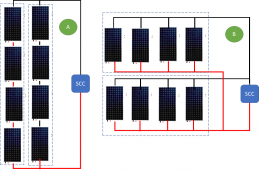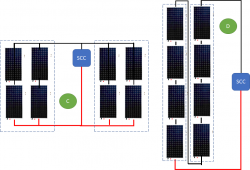Newbie here with a question about panel arrays and shading/wiring. I'm going to be using 8-200w, 22v, 10 amp panels in 2 arrays. Each 4 panel array will be facing the south and on the east side of my home. Both arrays will start to be hit at the same time by the shadow from my home in the mid afternoon, with the shadow slowly covering one panel after another on each array, as the day goes on. I've done some research but can't grasp which would be the best wiring scheme. Should I wire each array in series or parallel and then combine the two arrays in parallel to the controller or should each array have 2 panels in series and then parallel those 2 sets in with the other array. Hope this makes sense. I can then figure what size charge controller and wire I will need since the distance from the arrays to the controller will be approx. 50 ft. I don't have a specific power need. I am building this just to see what I can power with these panels using a 24v system with a couple SOK 200A batteries to start with until I figure out how much output on average I will get from these panels. Any advice or tips are appreciated.
You are using an out of date browser. It may not display this or other websites correctly.
You should upgrade or use an alternative browser.
You should upgrade or use an alternative browser.
Panel array question.
- Thread starter TomL
- Start date
acdoctor
Solar Enthusiast
About 80% of all power production will come from an area of the sky equal to using an analog clock time as an arc of sky from 10:30 to 1:30. Hope that makes sense. If you will have shading during that arc of sky I would reconsider the location. Arranging panels where the whole series string of panels goes in shading at the same time would be the most production. So maybe 2 in series that will suffer the at the same time then the next set. I prefer the higher voltage series strings myself but I don’t have any shading between the magical 10 to 2 arc of sky.
FilterGuy
Solar Engineering Consultant - EG4 and Consumers
There is no perfect answer.
In general, parallel panels are less susceptible to shading than series panels, However, most modern panels have bypass diodes that greatly reduce the impact of shading on a string of series panels because it 'bypasses' the shaded panel and allows the other panels in the string to continue to produce at full power. In fact, a lot of panels have 3 bypass diodes that make the panel work like 3 panels in series that each has a bypass diode. (One part of the panel can have shade while the rest of the panel keeps producing)
Meanwhile having everything in parallel greatly complicates the wiring and if there are more than 2 in parallel, there should also be string fuses on each.


(I don't think you asked about D, but I threw it in for completeness)
In the following, I am assuming the panels have bypass diodes.
Note: If your panels have 3 bypass diodes, the 3 zones of the panel are probably stripes along the long dimension of the panel. It is usually best to mount these in landscape orientation because as the sun comes up, the panel will start producing as soon as the top 3rd is in the sun.
In general, parallel panels are less susceptible to shading than series panels, However, most modern panels have bypass diodes that greatly reduce the impact of shading on a string of series panels because it 'bypasses' the shaded panel and allows the other panels in the string to continue to produce at full power. In fact, a lot of panels have 3 bypass diodes that make the panel work like 3 panels in series that each has a bypass diode. (One part of the panel can have shade while the rest of the panel keeps producing)
Meanwhile having everything in parallel greatly complicates the wiring and if there are more than 2 in parallel, there should also be string fuses on each.
I *think* these are the combinations you are asking about.Should I wire each array in series or parallel and then combine the two arrays in parallel to the controller or should each array have 2 panels in series and then parallel those 2 sets in with the other array.


(I don't think you asked about D, but I threw it in for completeness)
In the following, I am assuming the panels have bypass diodes.
- Based on what you have described, I would do D.
- If the voltage of D is too high for the SCC, or the wiring for D would be too difficult, I would do A.
- I would avoid B or C because it would require fuses or breakers on each parallel panel or string of panels.
Note: If your panels have 3 bypass diodes, the 3 zones of the panel are probably stripes along the long dimension of the panel. It is usually best to mount these in landscape orientation because as the sun comes up, the panel will start producing as soon as the top 3rd is in the sun.
Thanks for the info. The morning shade should be gone by 8:00am, the afternoon shade will start about 2:30-3:00pm, so that should work out for the best time of day. My location is pretty much fixed. I will be looking at FilterGuy's schematics and go from there.About 80% of all power production will come from an area of the sky equal to using an analog clock time as an arc of sky from 10:30 to 1:30. Hope that makes sense. If you will have shading during that arc of sky I would reconsider the location. Arranging panels where the whole series string of panels goes in shading at the same time would be the most production. So maybe 2 in series that will suffer the at the same time then the next set. I prefer the higher voltage series strings myself but I don’t have any shading between the magical 10 to 2 arc of sky.
FilterGuy, thanks for the schematics. The panels I ordered were Ecoworthy(I hope they are decent panels) and only have 2 diodes. I believe I would need to mount them in portrait mode because of the number and layout( according to the pictures ) of the cells and how the shade will hit the panels. Schematic A is the way I was thinking about building it and yes, the voltage on schematic D would be too high. I am going to be using a 100amp controller which will give me enough to maybe add another string later.There is no perfect answer.
In general, parallel panels are less susceptible to shading than series panels, However, most modern panels have bypass diodes that greatly reduce the impact of shading on a string of series panels because it 'bypasses' the shaded panel and allows the other panels in the string to continue to produce at full power. In fact, a lot of panels have 3 bypass diodes that make the panel work like 3 panels in series that each has a bypass diode. (One part of the panel can have shade while the rest of the panel keeps producing)
Meanwhile having everything in parallel greatly complicates the wiring and if there are more than 2 in parallel, there should also be string fuses on each.
I *think* these are the combinations you are asking about.
View attachment 117974
View attachment 117975
(I don't think you asked about D, but I threw it in for completeness)
In the following, I am assuming the panels have bypass diodes.
- Based on what you have described, I would do D.
- If the voltage of D is too high for the SCC, or the wiring for D would be too difficult, I would do A.
- I would avoid B or C because it would require fuses or breakers on each parallel panel or string of panels.
Note: If your panels have 3 bypass diodes, the 3 zones of the panel are probably stripes along the long dimension of the panel. It is usually best to mount these in landscape orientation because as the sun comes up, the panel will start producing as soon as the top 3rd is in the sun.
FilterGuy
Solar Engineering Consultant - EG4 and Consumers
As you wire the first two strings, remember that when you add the 3rd string, you will need to add fuses to all three strings. A little planning now may prevent major re-work later.I am going to be using a 100amp controller which will give me enough to maybe add another string later.

Fusing & Wire Sizing guidelines for solar panels
To get the paper, click on the orange'' button at the top of the screen. This resource is intended to help the user understand when they need to add Over Current Protection Devices (OCPDs - Fuses or Breakers) to the solar panel array and what...
However, keep in mind that when you add the 3rd string you may not be able to find the same make/model of panel as what you have now. (Many panels that were being sold just a year ago are already replaced by a newer model) In general, my recommendation is to match the SCC to your immediate plans with the assumption that future panels will have different characteristics and be on their own SCC.
acdoctor
Solar Enthusiast
I have 12 panels that are 19 VOC 33 cells. I can’t find any matching ones now.
I was already planning on adding a combiner box with room for the extra string and gauging the wire run to the SCC in case I add the string. I only want to deal with running the wire to the SCC once. I had not thought about the panels not being available though. Thanks again to you and acdoctor for the help.As you wire the first two strings, remember that when you add the 3rd string, you will need to add fuses to all three strings. A little planning now may prevent major re-work later.

Fusing & Wire Sizing guidelines for solar panels
To get the paper, click on the orange'' button at the top of the screen. This resource is intended to help the user understand when they need to add Over Current Protection Devices (OCPDs - Fuses or Breakers) to the solar panel array and what...diysolarforum.com
However, keep in mind that when you add the 3rd string you may not be able to find the same make/model of panel as what you have now. (Many panels that were being sold just a year ago are already replaced by a newer model) In general, my recommendation is to match the SCC to your immediate plans with the assumption that future panels will have different characteristics and be on their own SCC.
cotswoldstony
New Member
19-22 volt solar panels are not usually used for a 24 volt solar system because they need more wiring and fitting using twice as many panels.
Common mistake with solar beginners because it's seems easy to put a solar system together but the bigger the system the more problems.
Your solar array positions would work best with 38-44 volt half cut cell mono solar panels now industry standard for shading problems.
Common mistake with solar beginners because it's seems easy to put a solar system together but the bigger the system the more problems.
Your solar array positions would work best with 38-44 volt half cut cell mono solar panels now industry standard for shading problems.
Similar threads
- Replies
- 15
- Views
- 335
- Replies
- 17
- Views
- 588


